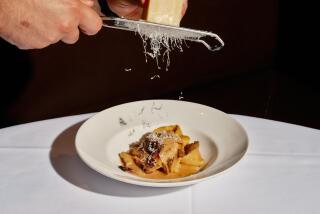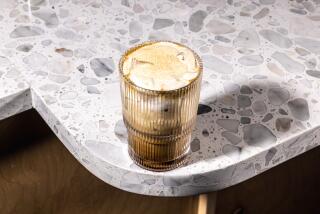Farmers Markets: How to be choosy with clementines
At their best, clementines are among the finest of citrus fruits, easy to peel, seedless, with firm but juicy flesh and a rich, well-balanced flavor. However, they can vary dramatically in quality, depending on the exact variety, the season, where theyâre grown, how theyâre grown and how theyâre packed and stored. For anyone who has fallen in love with this fruit only to be disappointed later, it is worth understanding these factors before shopping, whether at grocery stores or at farmers markets.
The original clementine, discovered by Father Clement Rodier in the garden of an Algerian orphanage in the late 1890s, was relatively small but high-flavored. It tended to be seedy, especially when grown near other citrus with viable pollen.
This so-called Algerian tangerine was introduced to California in 1914, where by the 1960s it was grown on a modest scale in desert districts. As grown there, it tended to dry out quickly, so its commercial cultivation eventually declined. Algerian became increasingly popular, however, in home gardens and small farms in Southern California, where it was ideally adapted to the Mediterranean-type climate. Currently grown on about 500 acres in California, Algerian remains the most widely available clementine variety at farmers markets and the standard of quality for flavor. Its seed content varies considerably, from none to a dozen or more, with larger specimens generally having more seeds.
The season for clementines in the San Joaquin Valley, from growers such as Arnett Farms of Fresno, starts in late November and peaks in December. The highest-quality clementines harvested in December are the Algerians grown by Jeffrey Rieger in the Sierra foothills, sold at Santa Monicaâs Wednesday market.
But the best is yet to come. Clementines are sweetest, juiciest and most aromatic in the Mediterranean-like climate of San Diego and Ventura counties, from growers such as Bob Polito and Peter Schaner of Valley Center and George Schnurer of Ramona. In this area the fruits ripen about a month later and hold remarkably well on the tree, so that the harvest runs from Christmas through February or March.
A variety similar to Algerian, Fina, was brought to Spain in 1925 and formed the basis of a substantial industry first aimed at exports to Europe. Imported Spanish clementines, sold in distinctive 5-pound crates, took Eastern U.S. markets by storm in the 1970s and â80s. These were grown on sour orange rootstock, which imparts superb flavor but is susceptible to the destructive tristeza virus.
In order to survive, Spanish growers had to take strong measures. They shifted to resistant rootstocks, which are less ideal for flavor; one, macrophylla, is particularly detrimental (âborderline sacrilege,â quipped one observer on a recent visit). They also planted a mutation of Fina discovered in 1953, Nules, which bears larger fruits and is easier to manipulate with natural growth regulators to produce large crops of seedless fruits. At its best it can be pretty good, but it is not as sweet and flavorful as Fina.
Spanish tax laws encouraged landowners to plant clementines on hundreds of thousands of acres, mostly in the Valencia region, south of Barcelona. The result, massive overproduction and low prices, has been exacerbated by the European economic crisis. Spanish growers have planted newer varieties, derived from mutations, which ripen earlier and later than Nules, extending the season but potentially confusing consumers.
When large California citrus growers recognized clementineâs sales potential in the 1990s, they focused on producing large quantities of seedless fruit at a competitive price. They primarily planted Nules, in the growing area where land and water suitable for citrus were most available, the San Joaquin Valley. This bold move was a great commercial success for the leading growers, Paramount and Sun Pacific, which marketed the easy-peeling, kid-friendly fruit as Cuties. More than 10,000 acres of clementines are now grown statewide.
Commercial clementines have two big advantages: a moderate price and consistent seedlessness. But clementine is not ideally adapted to the harsher, more continental climate of the San Joaquin Valley, particularly the summer heat. In addition, clementines, like most mandarins, suffer in quality from the washing, waxing and jostling of the packing process; this, along with prolonged storage, can cause off flavors and diminish the acidity necessary for a pleasing tang. The quality is clearly good enough to satisfy countless consumers around the country but may appear so-so to many of us lucky enough to have access to fresher clementines of better varieties grown in prime growing areas. The only drawback of farmers markets is that once one has tasted the best, itâs hard to settle for anything less.
Mindful shoppers may also want to bear in mind that to extend the clementine marketing season, many growers planted an unrelated mandarin, W. Murcott Afourer, and a seedless mutation, Tango. These are later in the season, deeper orange in color and arguably richer in flavor when grown in the San Joaquin Valley. Starting in January they will replace clementines in the Cutie box, where the two kinds are marketed interchangeably.
Scientists have long debated the ancestry of clementine, which was originally supposed to have resulted from a chance cross of Willowleaf mandarin and a sour orange; later, some claimed that clementine was identical to the Canton mandarin grown in southern China. Recent molecular marker studies have revealed that clementine is actually a hybrid of sweet orange and Willowleaf mandarin. Willowleaf, also known as Mediterranean mandarin, was the first mandarin brought from China to the Mediterranean basin, in 1805. It is most remarkable for the intense, distinctive âwildâ fragrance of the oils in its rind. Cementine, it seems, inherited a toned-down, more refined version of this aroma.
More to Read
Eat your way across L.A.
Get our weekly Tasting Notes newsletter for reviews, news and more.
You may occasionally receive promotional content from the Los Angeles Times.









